Webinar Transcript
Gavin Roberts Speaking: Welcome to the webinar, everyone. This is Gavin Roberts, Business Account Manager, signing in from India. There are a lot many people who have joined. Welcome all of you for this webinar today on the topic, ‘Secret to Avoid EPO Rejections in Patent Drawings’.
I will go on and introduce the topic and the esteemed speakers in our session today. I’m delighted to welcome all the participants from different countries. Your participation is a wonderful encouragement to the effort and attempts to raise awareness and spread knowledge. PatSketch owns this knowledge over several years of working with investors, R&D organizations, IP departments, and IP practices.
Our first speaker for this session is Hemant Kumar. He is the Senior Manager for the Illustration Team. He has an experience of 10 years in the patent industry with IP experience in patent illustration. Moreover, he has experience in Utility, Design, Plants, Office Action, Replacement sheets, etc. Welcome to the webinar, Hemant.
Hemant Kumar Speaking: Thanks, Gavin. Thanks for having me on the webinar. It’s a great pleasure to be here.
Gavin Roberts Speaking: Thank you, Hemant. It’s indeed a pleasure to have you as our lead speaker for today’s program.
Our second speaker for the session is Ankur Sharma. He’s a Senior Patent Illustrator with 3 years of experience in patent industries having IP expertise in patent illustration. Moreover, he also owns experience in Utility, Design, Plants, Office Actions, Replacement Sheets, etc. Welcome to the webinar, Ankur.
Ankur Sharma Speaking: Hey Gavin, thanks for having me on the webinar. It is a pleasure being here.
Related Article: The Importance of Patent Drawing Examples
Initial Remarks by the Speakers
Gavin Roberts Speaking: It’s a pleasure indeed to have you on board as our core speaker for today’s program. Further, we will start with the presentation today. I’ll ask our speakers for the initial remarks on today’s webinar topic, ‘The Secret to Avoid EPO Rejections in Patent Drawings’. Let’s begin with Hemant.
Hemant Kumar Speaking: Thanks, Gavin. Thank you, everyone, for joining us today. In today’s webinar, I’m going to share something that took me a while to figure out. It is about ‘How to Prepare Formal Patent Drawings for EPO PCT File’. In other words, it is about ‘how you can avoid EPO rejections in patent drawings’.
Moreover, I will walk you step by step through the exact requirements for fighting rejection proof drawings. Therefore, this webinar will not only help the audience to create a checklist. It will also help them to stay ahead of the EPO rejections in patent drawings. These objections are easy to overcome. However, they can increase client cost and grant time.
Gavin Roberts Speaking: Thank you, Hemant. Let’s now ask Ankur to share his initial remarks.
Ankur Sharma Speaking: Thank you, Gavin and Hemant. This webinar will take you ahead with how the guidelines come into play while responding to an EPO rejection in patent drawings. Further, we will understand this vastly and make it more knowledgeable. We’ll take you through some of the live case studies of EPO rejection in patent drawings. Moreover, we’ll understand the need to require a patent drawing expert to deal with these objections. Finnaly, a professional approach of an illustrator helps us avoid the EPO rejections in patent drawings.
Related Article: All You Need to Know about Latest US Patent Drawings Rules
Key Announcements
Gavin Roberts Speaking: Thank you, Ankur and Hemant, for setting the context for this webinar. Moreover, I have an announcement on this. The PatSketch team is offering up to 4 patent drawings at no cost to all attendees. The offer is valid for a single request only. The participants of our webinar can drop us an e-mail at [email protected], and we’ll share it with them. Let’s start with the main part of the presentation. I invite Hemant to take us through the webinar. Over to you, Hemant.
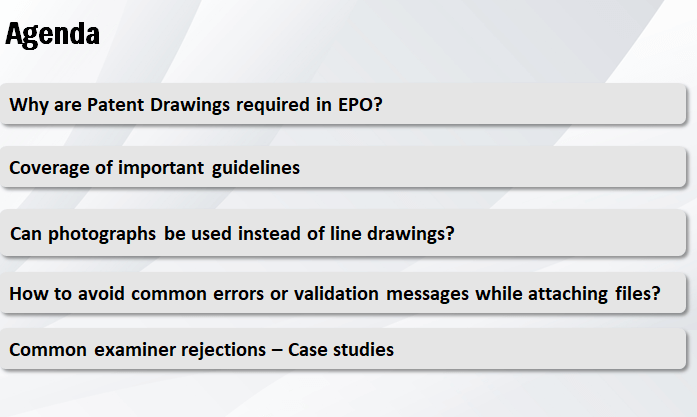
Hemant Kumar Speaking: Thank you, Gavin. Let us start with the PPT. We will be covering the following points today.
- Why are patent drawings required in EPO?
- Coverage of important guidelines.
- Can we use photographs instead of line drawings?
- How to avoid common errors or validation messages via attaching files.
- Examiner errors.
- Common examiner rejections with the help of case studies.
Also Read: The top 6 most unusual drawings for Patents
Why are patent drawings required in EPO?
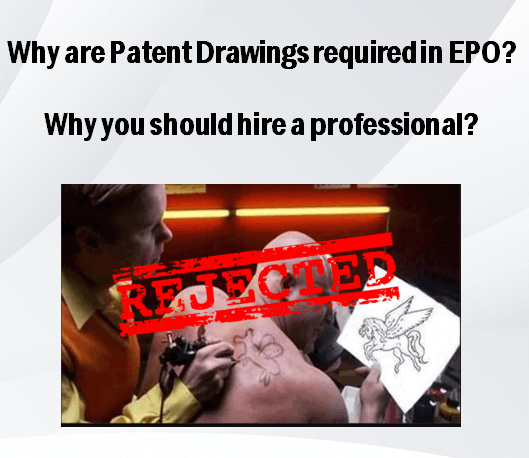
The well-made drawings are very important and add additional value to your patent application. Patent drawings are a mode of secondary language that helps the professionals and the examiners interpret the invention. Thus, EPO considers these drawings necessary for the examiners to read, understand the invention. For this office reason, you must always hire professionals.
This is because a single professional approach like this can ruin all your efforts. Moreover, it can also lead to an office action. This depicts that your drawings do not portray the invention accurately and do not comply with the EPO guidelines.
Related Article: The Latest Patent Drawings Cost
Importance of these Guidelines
This section comprises of two parts. According to EPO, there are two types of graphical forms considered as formal patent drawings. One of them is technical drawings, and the second is the photograph.
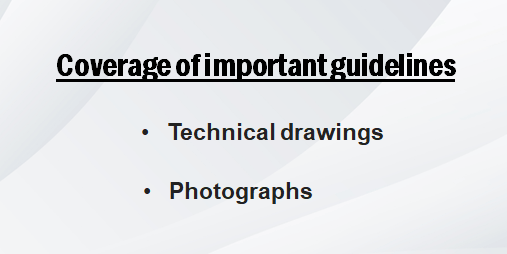
Technical Drawings
Technical drawings are also known as EPC – Engineering Procurement Construction. These drawings include perspective views, section views, and cross-sections. Moreover, these drawings help you get an idea about the invention with various inside details. Further, technical drawings cover flowcharts, diagrams, and graphic representations as well.
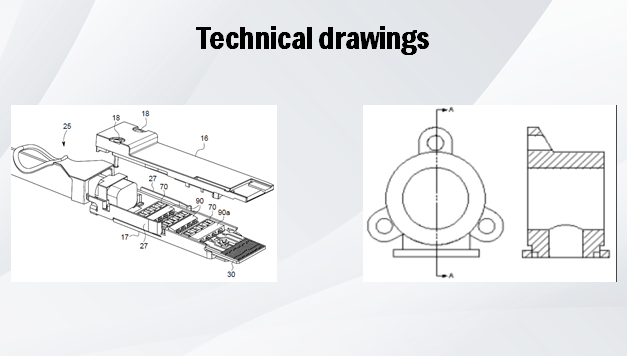
European Patent Convention Rule 46 – Patent Drawings Requirements
Sheet size and Margin Areas
There is multiple sheet size including US letter size, A-0, A-4, etc., used for formal drawings within multiple jurisdictions. However, EPO only allows A-4 sheet size, which is 41 by 49.7 cm. Further, you can only utilize 26.2 by 17 cm for formal drawings.
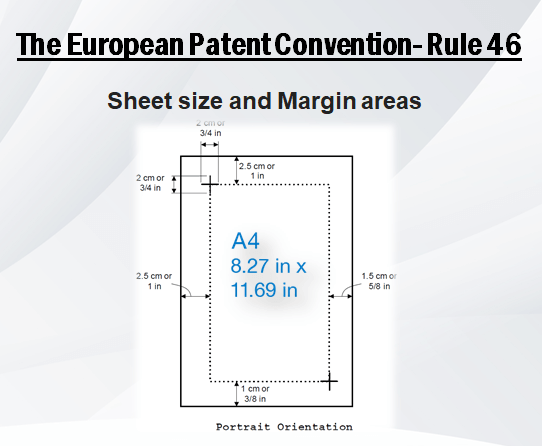
The margins can be followed as:
- top – 2.5 cm;
- left – 2.5 cm;
- right – 1.5 cm;
- bottom – 1 cm;
Moreover, you must not place these drawings across the marginal area. The images used here are for an example. Moreover, the dotted-lines and the measurements are for illustration purposes, and you must not include these in the final draft.
Also Read: What is the Design Patent Drawings Requirement?
Execution of Drawings
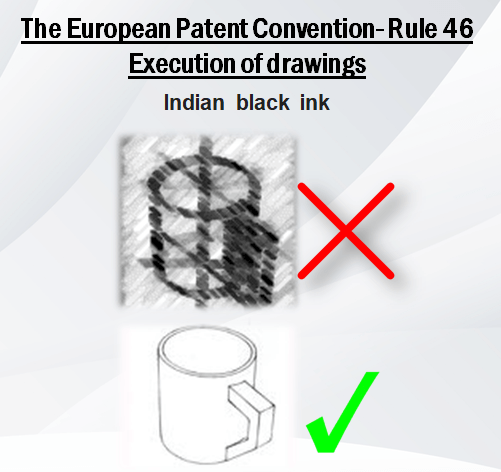
One must line the drawings using Indian black Ink with an RGB value of zero. This Ink is highly pigmented and remains light, fast, and permanent. Moreover, it is waterproof after buying. Thus, it helps in maintaining the adequate quality of drawings while printing or scanning. Moreover, one must not execute the drawings without coloring in durable black with uniform thickness and strokes.
This means that one must not use any hand-sketches or blood-drawings as formal patent drawings. Further, one must incorporate all the lines in the drawings with the aid of drafting instruments. PatSketch uses AutoCAD, Visio, CoralDraw, Illustrator, Solidworks – as per its client requirements. You can use any one as per your feasibility.
Related Articles: Tips & Tricks for High-Quality Patent Draft
Font Style or Size
Formal drawings contain several drawing texts including numbers, letters, and reference characters. One must incorporate this content with a uniform style and size. Moreover, one must orient these in the same direction as the drawing. This avoids rotating the sheet over and over again. Additionally, they should not cross, overlap, or intersect with any object, to maintain sanity.
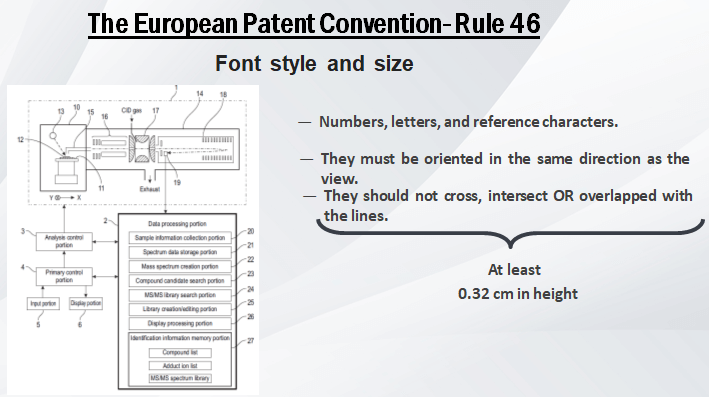
Furthermore, one must arrange these reference characters to follow the profile of the object depicted in the patent application. You must make sure not to use any brackets, circles, or inverted commas in association with numbers or letters. Additionally, there is another most important guideline and ignore aspect, which leads to an office action. It is the size or height of the font. Hence, the desirable size must remain at least 0.32 cm. Further, one is not eligible to use any context, text, or reference characters less than 0.32 cm.
Also Read: What is The Role of an Intellectual Property Paralegal?
Photographs – The Second Type of Graphical Form
As per the EPO, photographs are not permitted for utilization. However, there are some rare occasions where one can use photographs. You can use photographs where it is impossible to present the invention with the help of technical drawings. For example, you can use images per se diagrams, plants, Vivo images, or micro–entities. These include micro-organisms as one cannot portray those using line drawings.
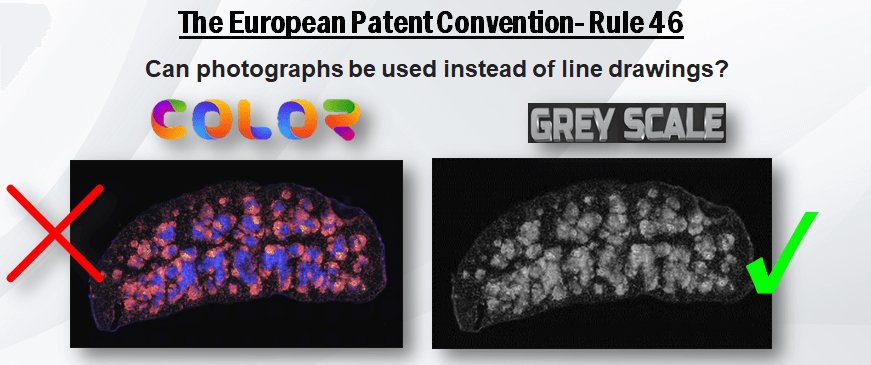
Further, you can submit photographs by fulfilling the applicable requirements for the patent drawings. However, the key point here to note is that you cannot find the patent drawings with colored drawings in EPO. You must convert these photographs to black and white or grayscale photographs. This aids in complying with the EPO guidelines to avoid unnecessary office actions.
Arrangements, Appropriate Sequence, and Numbering
Patent drawings must include a large number of views to portray the invention. The list of views covers the following types.
- Perspective view
- Front view
- Elevation view
- Rearview
- Right view
- Top and bottom views
- Isometric view
- Detailed, enlarged, and partial views
- Sectional views
- Partial sectional exploded, and assembled view, which can be used for design patent application.
Thus, all these seven views from the top are the standard requirements for the design patent application process. Moreover, utility patent drawings also encompass all the views from the list.
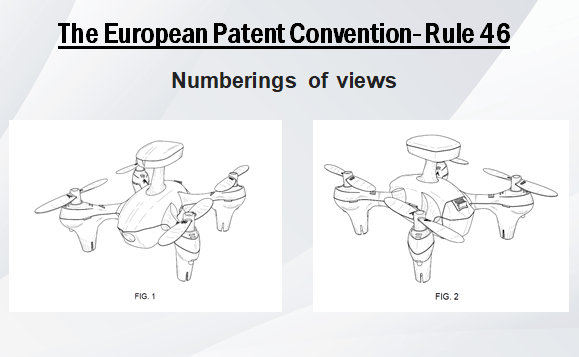
Furthermore, after placing these drawings, you must number the views in Arabic numerals. For example, you must denote the first drawing as Fig. 1; the second drawing as Fig. 2, and so on. Further, you must go through the entire section of guidelines before converting the application into a preferable format for submission via the eEPO-filing portal.
Also Read: Ways to Improve Patent Drawings Quality
Avoid Common Errors or Validation Messages
- Supported Browser for WIPO accounts and the eEPO system must include Mozilla Firefox and Internet Explorer.
- Format: you must use the PDF format to upload your formal drawings on the portal.
- Single document or multiple documents: you can attach formal drawings with descriptions, claims, and the abstract as a single or a PDF document/attachment. Moreover, it is also possible to indicate if the attached single specification file contains the sheets of drawings. The user can either include drawings in the single specification document or attach them as separate files.
- You must upload PDF format within the range of 300 DPI (dots per inch) to 350 DPI with embedded fonts.
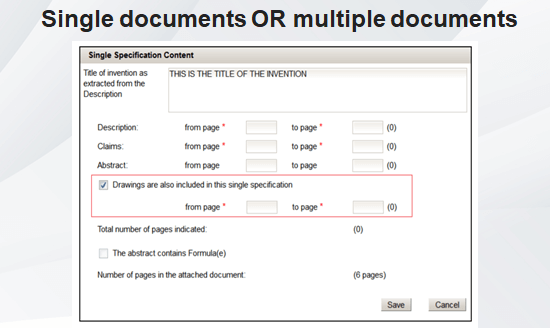
Hence, after ensuring all the aforementioned points, you are eligible to submit your formal patent drawings with ease. This is all about the first part of the session. I hope the audience found this piece of information insightful. Over to you, Gavin!

Gavin Roberts Speaking: Thanks, Hemant for the comprehensive overview of realizing the importance of formal patent drawings for EPO. You also shed light on hiring a professional patent illustrator who is technically sound with all the patent laws. Let’s move on to Ankur. Let us ask Ankur to walk us through the second part of the topic. Over to you, Ankur!
Ankur Sharma Speaking: Thank you, Gavin and Hemant.
Also Read: How to Invest Less in Patent Drawings?
Consumer Patent Rejections – Case Studies
This section takes you closer to the process of ensuring that your drawings can avoid any rejection under EPO guidelines. Moreover, this section talks about how the EPO guidelines work while filing a draft or responding to an office action. Further, it also delivers insights on how these guidelines and rules may cause rejection. It also talks about the misuse of the filing costs when filing without the guidance of an expert.
These rules and regulations also include important guidelines for using photographs as per an EPO. The European Patent Office doesn’t have any form of provision for photographs. You can only use them where it is not possible to represent a painting through line drawings. Hence, this is the topic of our first case study.
Case Study-1 – Photographs in EPO
One of the leaders was present in the design, and manufacturing of medical imaging products with distribution, both domestically and internationally. He required assistance in filing patent drawings related to auto-radiographs. We know that auto-radiographs are imaging techniques that use radioactive sources. Moreover, they comprise exposed samples including cellular components like DNA, RNA, protein, or lipids. These samples are labelled with suitable radioisotopes. Thus, they own a complex structure and minute visual details. Hence, it is not possible to illustrate that with the help of line drawings.
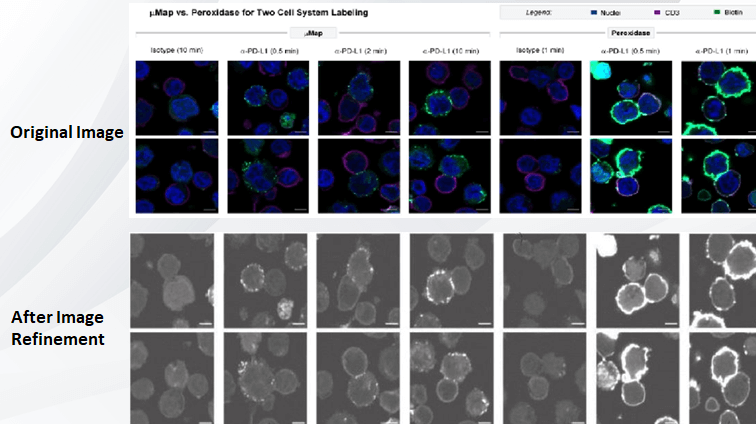
Here is the original image we had received from the client. He could have used this picture directly for the application process. However, they were well-aware of the consequences of receiving objection on patent drawings. This was due to the specific guidelines meant for these domains. Hence, instead of taking the risk of rejection, they decided to approach the patent drawings professionally. These professionals provide formal patent drawings that comply perfectly with the EPO guidelines. Thus, this is where we came into action and helped them in providing the patent drawings as per the guidelines.
Moreover, specifications may lead to potential EPO rejections in patent drawings. Only an expert owns the knowledge, experience, and tools to deal with such situations. The same happened here. The process to make the auto-radiographs apt for filing through an EPO went through multiple steps, including image refinement.
Moreover, auto-radiographs are usually blurred and poorly visible. Therefore, we used multiple applications, including Photoshop and image processing applications to maintain the DPI of images. This helped in sharpening quality and visibility. This is why we must consult an expert who predicts the best DPI for printed images.
Preparation
After refining and enhancing the resolution of images, we inserted them into CAD programs. Next, we added all the needed information as per the patent application requirements. This included reference numbers, figure numbers, sheet numbers, and other informative text.

Complying with EPC or EPO
One must incorporate all the required information, including image, text, referral, numerals, etc., Further, one must ensure that the drawings follow all the patent office guidelines. Otherwise, the patent application may go through multiple EPO rejections in patent drawings. Thus, we went through all the checkpoints including margins, text size, image quality, line quality, sheet size, and the required views.
Hence, after conducting multiple quality checks, the formal drawings were shared with the client. The drawings satisfied the client with the output. Further, he filed the patent application with the secure thought of not receiving any EPO rejections in patent drawings. Thus, this was one of the cases that required professional help while filing the patent to EPO.
Related Article: 5 Major Misconceptions about Patent Invention Drawings
Case Study-2
This case study highlights a client’s problem where he directly files the pictures for a design patent application at the EPO. Further, he received a rejection over it. This client got pictures of the design that he wanted to file to EPO under the design patent application. He did not consult a patent drawing expert and filed those images directly to the office. Thus, he received rejection over the reproduction of pictures.
It had insufficient views, inconsistency with the drawings, and had indistinguishable claims. Thus, they needed our assistance in formalizing the design drawings as per the EPO guidelines.
Related Article: Patent Drafting: A Primary Guide for Beginners
Major Guidelines for Every Design Patent Application
There are some major guidelines that every design patent application must follow.
- Design specification must include a line drawing or a black and white photograph of the claimed design.
- Clarity of claim: the drawing must be clear and complete. You must not leave any aspect of the design prone to presumptions.
- Adequate numbers of views: the drawing must include a sufficient number of views.
Thus, based on these points, we must proceed step by step.
The First Step Constituted of Line Drawings
We formalized the line drawings of design products considering the details and claims. Moreover, this was based on the pictures and office action instructions as well. It prepared all the standard views so that the design details get proper exposure for clear understanding.
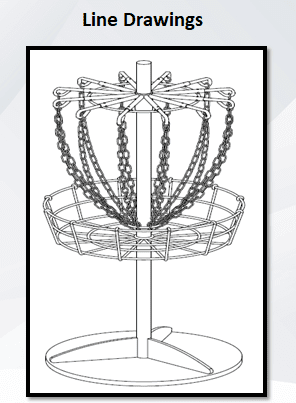
Projection of different views
The task did not end with preparing the line drawings for different views. Moreover, all the parts and the views must consistently portray a projection for each other.
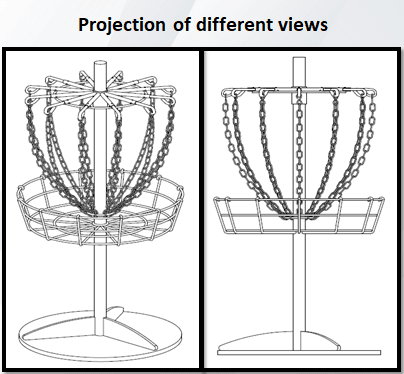
Distinguish Claimed Part
We formalized the line drawings of different views with consistent projections. However, during that process, it was most essential to differentiate the declaimed portions from the rest of the parts. This involves a close understanding of the guidelines of patent offices. Thus, we showed the portions which are not considered as part of the claimed design. These included dash and broken lines. Moreover, this was differentiated with a claimed design for proper and easy understanding.
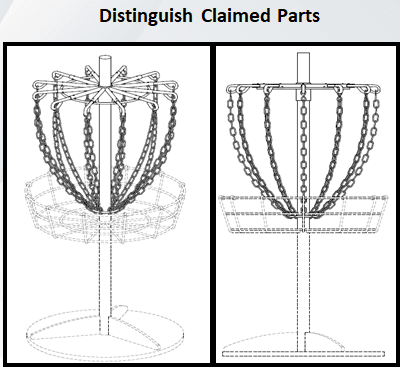
Surface Shading
This relates to portraying the surface of the part and the models. We use appropriate surface shading to clearly show the contour of all surfaces of any three-dimensional aspects of the design.
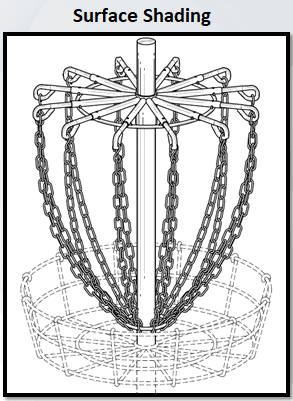
Therefore, we went through these levels of correction while preparing drawings. Further, we also compared the amendments with the instruction of office actions and guidelines of the EPO. Finally, we submitted the replacement sheets to the client. We followed these steps to ensure that the design drawings are filed without any objection.
Also Read: What is a Non-Provisional Utility Application?
Case Study–3
This Case Study is the simplest looking and delivers an easy to apply the approach for EPO guidelines. It also delivers one of the most seen errors that cause rejections. Further, these EPO rejections in patent drawings occur when one does not approach a professional illustrator while preparing the drawings.
Rejection Due to Margin Error
A client had approached us with an office action based on the margin errors received from the EPO. Hence, one must keep the drawings under certain specified margins to ensure that your drawings are rejection proof. Moreover, there are other possible reasons behind the margin error as well.
- Over scaling of drawings: this is where the figures have a high scale ratio. Moreover, this ratio is high enough to exceed the margin boundaries, thus, causing EPO rejections in patent drawings.
- Overcrowded sheets with figures: this happens when a sheet is over-flooded with drawings. When one keeps multiple figures on a single sheet, it makes the gap between drawings and margins, less. Thus, printing this creates an illusion that the figures are moving out of marginal boundaries.
Also Read: EPO Patent Drawing Rules
How Can You Overcome These EPO Rejections in Patent Drawings?
- Use appropriate scaling: One must use the proper ratio of drawing on the sheet and in the margin area. You must create a drawing with a scale showing the mechanism of the invention without crowding.
- Space between margin and drawings: One must keep an appropriate distance between the boundaries and the figures. This is so that the gap is visible properly on the paper.
- Stick to the guidelines: This is one of the most common parameters. One must ensure to keep the margin according to the EPO regulations.
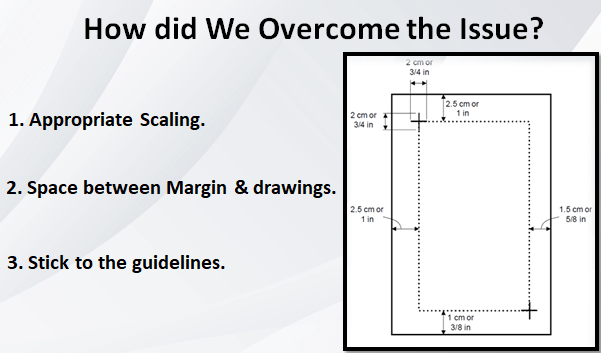
Useful Practices & Techniques
We must conduct a few techniques and practices so that these guidelines are considered while preparing patent drawings.
- Number of figures per page: You must maintain the number of figures in between page margins.
- Scale of figures and texts: One must use this to overcome the issue of margin error. Moreover, one can reduce the scale of figures and maintain the text size, not less than 3.2 cm to overcome this issue.
- Proper quality check: This is the most important key to avoid any rejection. One must recheck the size of paper and margins before sending them for filing.
Hence, we were able to deliver the correct drawings within the margins as specified under the EPO guidelines. Moreover, this was only possible as we followed the guidelines mentioned above. The patent got approval on those drawings from the judiciary and gave us another happy and satisfied customer. Thus, one does not obtain patent grants by possessing only partial knowledge of the rules and regulations.
This is when a patent drawing professional comes into the role. Meeting all the requirements mentioned in an office action, and making particular amendments cannot always ensure approval. Hence, one must seek the help of a paid patent illustrator. They match all the standards and guidelines in compliance with the different country offices. They use their expertise, and knowledge with the latest software to reduce the time, effort, and high expenses of a rejection.
Thus, these case studies will help you to analyze different stages, problems, and solutions to avoid any rejection while filing a patent application.
Related Article: The Latest Patent Filing Trend
Questions & Answers
Gavin Roberts Speaking: Thank you, Ankur for this elaborate coverage. Hemant and you have covered a lot of grounds on this topic. The audience is having a lot of questions and we will take a few of those here.
Is Portrayed Orientation Mandatory?
Hemant Kumar Speaking: Keeping drawings in either landscape or portrait orientations are not restricted. However, it is always a good practice to follow any one orientation for the entire drawing. They help in reviewing the drawings without opening them over and over again, without troubling the examiners.
Can You Give Measurements in Line Drawings?
Ankur Sharma Speaking: That one is the most raising question for patent drawings. Mentioning dimensions in patent drawings is not allowed. We must maintain the ratio of parts and drawings if the client wants to stick to the dimension of parts of the patent drawing.
How Detailed is a Drawing Required to Have a Proper Illustration?
Hemant Kumar Speaking: This is indeed a good question. We must understand that the drawings must reflect all the features that are necessary to show. Moreover, when it comes to patent drawings, it completely depends on the claims and the descriptions of the application. Formal drawings must show all the features, and all the details present in the description part. This is because design patent applications patent drawings are the only source to show the claimed portion of the invention.
I have Already Filed My Drawings in the US. Can I Use Them for EPO?
Ankur Sharma Speaking: This is one of the most asked questions. Although there are some common guidelines among different judiciaries, like EPO and USPTO, there are differences too. Thus, you must seek guidance from any professional. Further, you can also watch our last webinar that displays universal rules and regulations that are common among different patent offices.
Also Read: Why Should You Invest in a Good Patent Illustration Service?
Final Remarks
This was a wonderful session. I’m sure our listeners have great takeaways from this session. Further, they will use several of these pointers in working on patent drawings for the businesses. We have covered all the questions that we received from our audience. Thus, the ones we could not cover will be answered in the write-up that we publish post this webinar. Thank you all speakers for this wonderful webinar today.
PatSketch is offering up to 4 drawings at no cost for the attendees, and the offer is valid for single requests. To avail the same, participants can send an e-mail to [email protected] . Also, I would like to extend a big thanks to all our listeners who helped us start on time and finish, as well.We highly appreciate that. Thank you very much for this. Please join us in the next webinar, and have a great day ahead. Thank you so much, everyone.
Other Related Articles
Patent Watch: Why Do I Need It?
